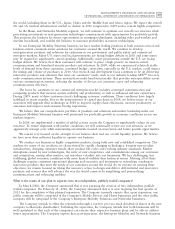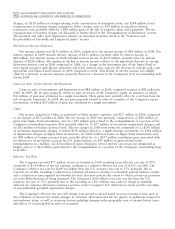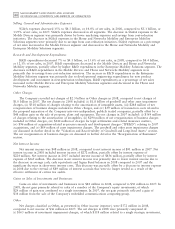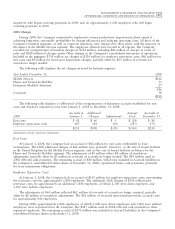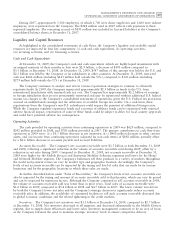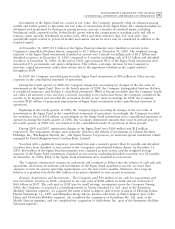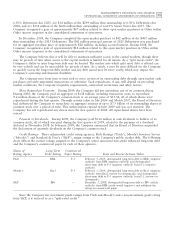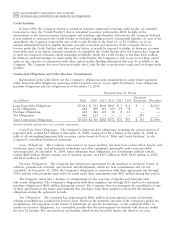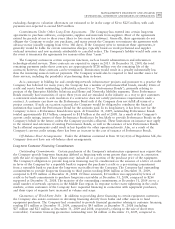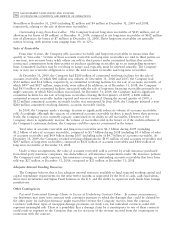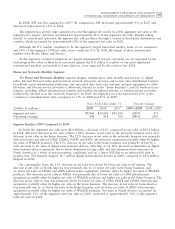Motorola 2009 Annual Report Download - page 57
Download and view the complete annual report
Please find page 57 of the 2009 Motorola annual report below. You can navigate through the pages in the report by either clicking on the pages listed below, or by using the keyword search tool below to find specific information within the annual report.
49
MANAGEMENT’S DISCUSSION AND ANALYSIS
OF FINANCIAL CONDITION AND RESULTS OF OPERATIONS
During 2007, approximately 5,300 employees, of which 1,700 were direct employees and 3,600 were indirect
employees, were separated from the Company. The $248 million used in 2007 reflects cash payments to these
separated employees. The remaining accrual of $193 million was included in Accrued liabilities in the Company’s
consolidated balance sheets at December 31, 2007.
Liquidity and Capital Resources
As highlighted in the consolidated statements of cash flows, the Company’s liquidity and available capital
resources are impacted by four key components: (i) cash and cash equivalents, (ii) operating activities,
(iii) investing activities, and (iv) financing activities.
Cash and Cash Equivalents
At December 31, 2009, the Company’s cash and cash equivalents (which are highly-liquid investments with
an original maturity of three months or less) were $2.9 billion, a decrease of $195 million compared to
$3.1 billion at December 31, 2008. At December 31, 2009, $547 million of this amount was held in the U.S. and
$2.3 billion was held by the Company or its subsidiaries in other countries. At December 31, 2009, restricted
cash was $206 million (including $143 million held outside the U.S.), compared to $343 million (including
$279 million held outside the U.S.) at December 31, 2008.
The Company continues to analyze and review various repatriation strategies to continue to efficiently
repatriate funds. In 2009, the Company repatriated approximately $2.5 billion in funds to the U.S. from
international jurisdictions with minimal cash tax cost. The Company has approximately $2.2 billion of earnings
in foreign subsidiaries that are not permanently reinvested and may be repatriated without additional U.S. federal
income tax charges to the Company’s consolidated statements of operations, given the U.S. Federal tax provisions
accrued on undistributed earnings and the utilization of available foreign tax credits. On a cash basis, these
repatriations from the Company’s non-U.S. subsidiaries could require the payment of additional foreign taxes.
While the Company regularly repatriates funds and a portion of offshore funds can be repatriated with minimal
adverse financial impact, repatriation of some of these funds could be subject to delay for local country approvals
and could have potential adverse tax consequences.
Operating Activities
The cash provided by operating activities from continuing operations in 2009 was $629 million, compared to
$242 million provided in 2008, and $785 million provided in 2007. The primary contributors to cash flow from
operations in 2009 were: (i) a $1.3 billion decrease in net inventory, (ii) a $960 million decrease in other current
assets, and (iii) income from continuing operations (adjusted for non-cash items) of $892 million, partially offset
by a $2.6 billion decrease in accounts payable and accrued liabilities.
Accounts Receivable: The Company’s net accounts receivable were $3.5 billion at both December 31, 2009
and 2008, reflecting a significant reduction in the volume of accounts receivable sold during 2009, offset by a
reduction in net sales during 2009. Compared to December 31, 2008, net accounts receivable at December 31,
2009 were higher for the Mobile Devices and Enterprise Mobility Solutions segments and lower for the Home
and Network Mobility segment. The Company’s businesses sell their products in a variety of markets throughout
the world and payment terms can vary by market type and geographic location. Accordingly, the Company’s
levels of net accounts receivable can be impacted by the timing and level of sales that are made by its various
businesses and by the geographic locations in which those sales are made.
As further described below under ‘‘Sales of Receivables,’’ the Company’s levels of net accounts receivable can
also be impacted by the timing and amount of accounts receivable sold to third parties, which can vary by period
and can be impacted by numerous factors. Although the Company continued to sell accounts receivable in 2009,
the volume of accounts receivable sold was lower than in prior years. Total sales of accounts receivable were
$1.2 billion in 2009, compared to $3.4 billion in 2008 and $4.7 billion in 2007. The lower volume was driven
by both the Company’s lower net sales and the Company’s strategic decision to significantly reduce accounts
receivable sales. In addition, the availability of committed facilities to sell such accounts receivable decreased due
to global economic conditions and the related tightening in the credit markets.
Inventory: The Company’s net inventory was $1.3 billion at December 31, 2009, compared to $2.7 billion
at December 31, 2008. Net inventory decreased in all segments and decreased substantially in the Mobile Devices
segment, due to supply-chain efficiencies and lower sales. Inventory management continues to be an area of focus
as the Company balances the need to maintain strategic inventory levels to ensure competitive delivery


